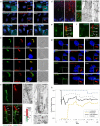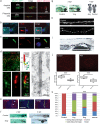CiliaCarta: An integrated and validated compendium of ciliary genes
- PMID: 31095607
- PMCID: PMC6522010
- DOI: 10.1371/journal.pone.0216705
CiliaCarta: An integrated and validated compendium of ciliary genes
Abstract
The cilium is an essential organelle at the surface of mammalian cells whose dysfunction causes a wide range of genetic diseases collectively called ciliopathies. The current rate at which new ciliopathy genes are identified suggests that many ciliary components remain undiscovered. We generated and rigorously analyzed genomic, proteomic, transcriptomic and evolutionary data and systematically integrated these using Bayesian statistics into a predictive score for ciliary function. This resulted in 285 candidate ciliary genes. We generated independent experimental evidence of ciliary associations for 24 out of 36 analyzed candidate proteins using multiple cell and animal model systems (mouse, zebrafish and nematode) and techniques. For example, we show that OSCP1, which has previously been implicated in two distinct non-ciliary processes, causes ciliogenic and ciliopathy-associated tissue phenotypes when depleted in zebrafish. The candidate list forms the basis of CiliaCarta, a comprehensive ciliary compendium covering 956 genes. The resource can be used to objectively prioritize candidate genes in whole exome or genome sequencing of ciliopathy patients and can be accessed at http://bioinformatics.bio.uu.nl/john/syscilia/ciliacarta/.
Conflict of interest statement
The authors have declared that no competing interests exist.
Figures





Similar articles
-
Whole-Organism Developmental Expression Profiling Identifies RAB-28 as a Novel Ciliary GTPase Associated with the BBSome and Intraflagellar Transport.PLoS Genet. 2016 Dec 8;12(12):e1006469. doi: 10.1371/journal.pgen.1006469. eCollection 2016 Dec. PLoS Genet. 2016. PMID: 27930654 Free PMC article.
-
Systematic discovery of novel ciliary genes through functional genomics in the zebrafish.Development. 2014 Sep;141(17):3410-9. doi: 10.1242/dev.108209. Development. 2014. PMID: 25139857 Free PMC article.
-
Functional genomics of the cilium, a sensory organelle.Curr Biol. 2005 May 24;15(10):935-41. doi: 10.1016/j.cub.2005.04.059. Curr Biol. 2005. PMID: 15916950
-
Zebrafish as a Model for Human Ciliopathies.J Genet Genomics. 2016 Mar 20;43(3):107-20. doi: 10.1016/j.jgg.2016.02.001. Epub 2016 Feb 12. J Genet Genomics. 2016. PMID: 27020031 Review.
-
Insights Gained From Zebrafish Models for the Ciliopathy Joubert Syndrome.Front Genet. 2022 Jun 30;13:939527. doi: 10.3389/fgene.2022.939527. eCollection 2022. Front Genet. 2022. PMID: 35846153 Free PMC article. Review.
Cited by
-
The transcriptional signature associated with human motile cilia.Sci Rep. 2020 Jul 2;10(1):10814. doi: 10.1038/s41598-020-66453-4. Sci Rep. 2020. PMID: 32616903 Free PMC article.
-
Ciliogenesis and autophagy are coordinately regulated by EphA2 in the cornea to maintain proper epithelial architecture.Ocul Surf. 2021 Jul;21:193-205. doi: 10.1016/j.jtos.2021.06.006. Epub 2021 Jun 11. Ocul Surf. 2021. PMID: 34119713 Free PMC article.
-
The essential role of primary cilia in cerebral cortical development and disorders.Curr Top Dev Biol. 2021;142:99-146. doi: 10.1016/bs.ctdb.2020.11.003. Epub 2021 Jan 25. Curr Top Dev Biol. 2021. PMID: 33706927 Free PMC article. Review.
-
Impact of 5-HT6 Receptor Subcellular Localization on Its Signaling and Its Pathophysiological Roles.Cells. 2023 Jan 27;12(3):426. doi: 10.3390/cells12030426. Cells. 2023. PMID: 36766768 Free PMC article. Review.
-
CiliaMiner: an integrated database for ciliopathy genes and ciliopathies.Database (Oxford). 2023 Jul 26;2023:baad047. doi: 10.1093/database/baad047. Database (Oxford). 2023. PMID: 37542408 Free PMC article.
References
Publication types
MeSH terms
Grants and funding
LinkOut - more resources
Full Text Sources
Molecular Biology Databases
Research Materials

